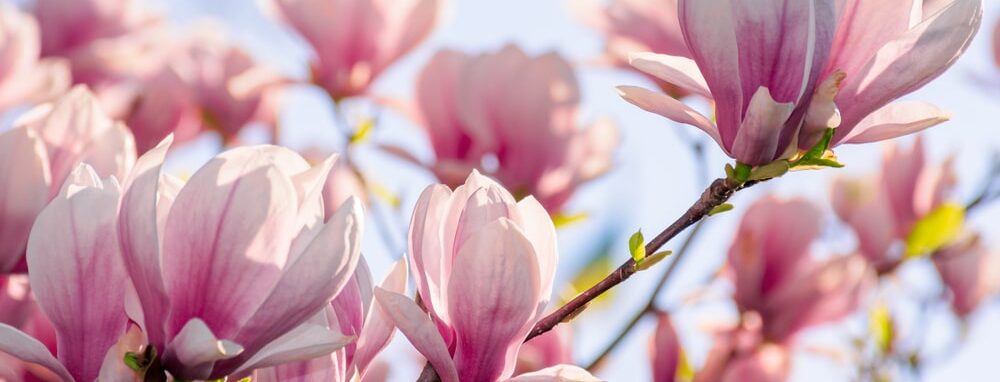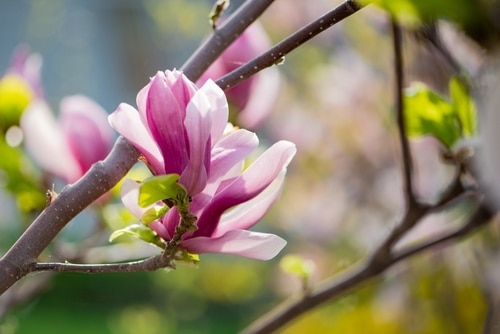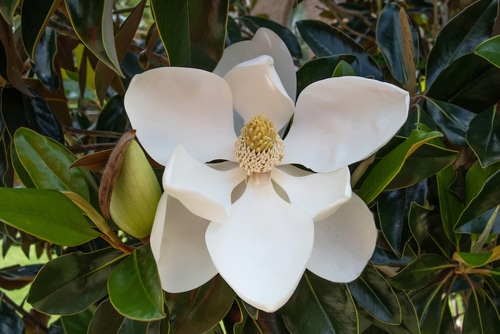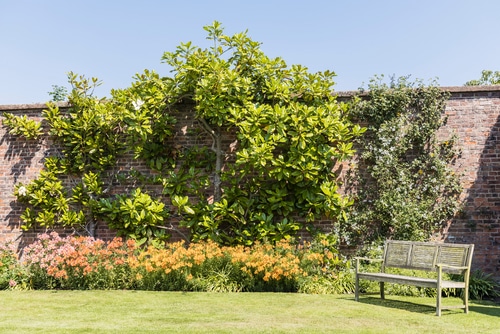Log in or create new account to save this product to your wishlist.

Pruning Your Magnolia Tree: When, Why, & How?
Magnolias, with their large flowers, bloom in spring or summer, creating a breath-taking display. Find out how to prune your magnolia tree with our guide.
🌱 All important maintenance moments for your lawn during the year. Leave your email and we will send you the lawn calendar for free.
Enter your email
Receive the lawn calendar in the mail
Enjoy a green lawn all year round!

- Order by 2PM = shipped today
- 250.000+ satisfied customers!
- 60 day satisfaction guarantee
Magnolia trees, with over 80 species, are admired for their robust, leathery leaves and stunning flowers, which can be white or tinged with pink. And while these beautiful trees require little maintenance, pruning your magnolia tree is one task to approach with caution.
- Magnolia tree types: Deciduous vs. Evergreen
- How does pruning differ for evergreen and deciduous magnolias?
- Why prune your magnolia tree?
- How to train a magnolia tree by pruning
- When to prune your magnolia tree
- How to prune a magnolia tree
- FAQs
But don’t panic! It’s not difficult; it’s just essential that you’re gentle and don’t go mad with the pruning shears.
This article is about when, why, and how to prune your magnolia tree for outstanding results (for minimal effort!).
Ready? Let’s go!
Magnolia tree types: Deciduous vs. Evergreen

Firstly, let’s distinguish between the two primary types of Magnolia trees:
- Evergreen Magnolias: Examples include Little Gem Magnolia, Bracken’s Brown Magnolia, and DD Blanchard Magnolia.
- Deciduous Magnolias: Examples include Ann Magnolia, Jane Magnolia, and Alexandrina Magnolia.
What’s the difference?
Well, deciduous trees shed their leaves in winter, whereas evergreen trees retain their leaves throughout the year. Evergreen magnolia trees are vibrant and full of life, while deciduous trees are lush and dense and grow faster than their evergreen counterpart.
How does pruning differ for evergreen and deciduous magnolias?
Unlike other garden shrubs, bushes or trees, magnolias generally require very little regular pruning. In fact, it’s typically considered best to avoid pruning a magnolia unless the plant has become overgrown, lost its shape, or has dead or diseased branches.
Deciduous magnolias

These trees lose their leaves in the winter, so pruning is rarely required. However, there are some circumstances where you may want to prune:
- Removing dead, diseased, or damaged wood to keep the tree healthy
- Reducing the tree’s size, aiming for a balanced, open crown — thin out the stems to a side shoot or the trunk — but prune gradually over several years to avoid damaging the plant.
- Renovating a malformed or old tree, spreading the pruning over several years as older trees recover very slowly.
Evergreen magnolias

Never hard-prune an evergreen magnolia. Like deciduous varieties, pruning should be confined to removing dead and diseased wood and shaping young trees shortly after planting them. Remove long branches at the top and remove the lower boughs to encourage a bare stem at the base.
Why prune your magnolia tree?
Your main objectives when pruning your magnolia tree are:
- To remove the dead and diseased branches, and
- Cut back the water shoots — these distinctive fast-growing shoots grow directly upwards.
Water shoots grow rapidly and zap the tree’s energy and nutrients, leading to disappointing growth. While they proliferate, water shoots offer weak natural growth and will result in poor flowering.
Bad times.
So, pruning is a tried-and-tested approach to refreshing a tree’s vigour, allowing it to focus its energy towards flowering.
However:
It’s essential to prune at the right time of year.
How to train a magnolia tree by pruning

Some evergreen magnolias grow and flower well when trained to warm sunny walls. One particular variety that thrives in these conditions is the M. grandiflora, offering a gorgeous spread across the wall.
To train your magnolia, follow these steps:
- Attach supports to the sunny wall — use a trellis or horizontal wires, and tie the branches at 45 degrees for the first season, lowering to horizontal for the second. This boosts flowering while helping the branches spread across the wall.
- Remove in-growing shoots — cut back the shoots growing inwardly towards the wall in the summer and shorten outwardly extending shoots to a couple of leaves.
- Delay pruning till after flowering
When to prune your magnolia tree
The only time you should prune a deciduous magnolia is after flowering — between mid-summer and the first signs of autumn. If you prune these varieties between late winter and early spring, the branches will bleed sap, negatively impacting the tree’s vitality and potentially attracting pests and insects.
However, you should prune evergreen magnolias in spring, so it’s important to know what type of tree or bush you have.
When to prune young plants
Trim young magnolias in mid-to-late spring or whenever necessary. This involves shortening young, long branches and removing the lower boughs if they’re growing out of shape.
Inspect your tree for weak limbs and small or twirling branches that may make your plant appear misshaped. Also, look out for abnormally large branches and remove them!
How to prune a magnolia tree

Both Evergreen and Deciduous Magnolia Trees follow the same principle when it comes to pruning and trimming.
Use hand pruning shears to remove dying, dead, diseased, or weak branches, especially if you have just planted your tree. Cut the branches a quarter of an inch from the side shoot.
Remove suckers and water sprouts, which can inhibit the tree’s growth.
For thicker branches, consider fork pruning them by removing one of the forked branches back to its junction point. This helps the tree maintain its shape while reducing overall growth.
The essential pruning tools
Typically, pruning a magnolia involves simply removing thin and weak branches, so you should be OK with a set of sharp pruning shears. However, if you’re removing large or thick branches, you might need a saw and a ladder for taller branches.
And the universal pruning rule always applies: only ever prune with clean, sharp blades. Blunt blades will bruise and tear the plant, leaving it susceptible to disease, while sharp blades produce a clean cut.
Always clean your tools before and after pruning, using a horticultural detergent suitable for your specific tools. This helps prevent cross-contamination.
FAQs
Prune a deciduous magnolia after it has finished flowering between mid-summer and early autumn – avoid late winter/early spring, as the branches will bleed sap. Prune an evergreen magnolia tree in the spring before it has started flowering.
Magnolia buds typically form in late summer or early autumn, around the same time that the tree sheds its leaves. These buds remain dormant throughout the winter and start to swell and develop in early spring. Once the buds have reached the desired size, they will begin to open and reveal the beautiful magnolia flowers.
Deadheading, or removing spent flowers, is not typically necessary for magnolia trees. Unlike some flowering plants, magnolias naturally shed their flowers once they start to fade. Removing the spent blooms can disrupt the tree’s natural process and may even reduce the formation of new buds for the following year. It’s best to let the magnolia’s flowers fall off on their own.
Any questions?
Pruning your Magnolia tree correctly and at the right time can ensure a healthy, aesthetically pleasing tree that will be the highlight of your garden for years to come.
If you have any questions, please leave a comment below or drop us an email. Or check out our Help & Advice section for a range of comprehensive guides to your most challenging gardening and lawn care tasks.
Happy gardening!
-
How to Grow Eucalyptus in British GardensWith a little love and care, eucalyptus trees can thrive in English gardens. Since they don’t germinate well without proper help, there are not considered invasive. So, there is no reason not to plant them if you enjoy their looks.Read more
-
Transform Your Garden with All-Year-Round Flowering PlantsDid you know you can enjoy blooming flowers even in January? With the right selection of all year round plants, there’s no need to wait until spring to add some colour to your garden.Read more
-
How to Create a Butterfly Garden: A Simple Guide for British GardensThe UK's butterfly population includes 59 different species. These beautiful winged creatures face a steady decline because of habitat loss, pollution and changing weather patterns. Your garden can become a vital link between nature reserves and natural habitats. Let’s explore how.Read more
-
Volcanic Rock Dust for Your Garden—Application and TipsDid you know that volcanic rock dust is a brilliant organic soil improver? This article explains exactly what it's good for and how to use it properly.Read more
-
How to Use Landscape Fabric ProperlyIf weeds or erosion in your garden are troubling you, landscape fabric might be the solution. We’ll explain how and when to use it properly, just keep on reading.Read more
-
Hostas: A Complete Care GuideIf you have a north-facing garden or some shady corners on your property, hostas are the plants for you. These green delights thrive particularly well in partial to full shade and require consistently moist soil to perform at their best.Read more
-
How to Grow Grapes in Your Garden: A Simple Step-by-Step GuideGrapevines produce some tasty fruits, but often they are simply grown for their gorgeous leaves. Whatever your motivation may be, we have a guide on how to grow grapes for you.Read more
-
Worm Composting Made Simple: From Kitchen Scraps to Garden GoldDid you know that a single pound of composting worms can devour half their body weight in waste every day? That's roughly twelve pounds of kitchen scraps transformed into garden gold each month! We will look at how to make this happen.Read more
Leave a comment
Your answer will be displayed on the site and the interested party will be notified by email.
Leave a comment
Have a question or want to share your experience? Leave us a comment.

- Order by 2PM = shipped today
- 250.000+ satisfied customers!
- 60 day satisfaction guarantee

- Order by 2PM = shipped today
- 250.000+ satisfied customers!
- 60 day satisfaction guarantee

- Order by 2PM = shipped today
- 250.000+ satisfied customers!
- 60 day satisfaction guarantee

🌱 All important maintenance moments for your lawn during the year. Leave your email and we will send you the lawn calendar for free.
Enter your email
Receive the lawn calendar in the mail
Enjoy a green lawn all year round!
















 Summer Deal! Get 15% off the
Summer Deal! Get 15% off the 




Comments (0)
There are no comments yet. Well then, what are you waiting for to
Be the first to write your comment!inaugurate this pretty page?
Do you have some comments?